The Trade-Offs and Constraints of Watershed Ecosystem Services: A Case Study of the West Liao River Basin in China
Abstract
1. Introduction
2. Materials and Methods
2.1. Study Area
2.2. Data Source
2.3. Selection of Ecosystem Service Indicators
2.4. Carbon Storage and Carbon Emission
2.5. Water Yield and Water Use
2.6. Meat and Grain Production
2.7. Soil Conservation
2.8. ES Supply–Demand Ratio
2.9. Construction of Coupling Coordination Model
2.9.1. Dimensionless Index
2.9.2. Use the Entropy Weight Method to Calculate the Weight of Each Index
2.9.3. Calculate the ES Supply Index (ESSI) and ES Demand Index (ESDI)
2.9.4. Construction of Coupling Coordination Degree Model
2.9.5. Construction of Supply and Demand Matching Model
2.9.6. Decoupling Model
2.10. Geographically and Temporally Weighted Regression (GTWR)
3. Results
3.1. Characteristics of Spatial and Temporal Variations in Supply, Demand, and Supply–Demand Ratios
3.2. Spatial and Temporal Dynamics of ESSI and ESDI
3.3. Spatiotemporal Influence of CD and MD
3.4. Spatial and Temporal Variation in Decoupling Indices
3.5. GWTR
- (1)
- population declines in Horqin District, Horqin Left Rear Banner, Hure Banner, Bairin Left Banner, Kailu County, Naiman Banner, Horqin Left Middle Banner, and Aohan Banner exerted a positive impact on the coupling coordination degree. In contrast, the population change in other regions negatively influenced the degree of coupling coordination. The average impact coefficients were 0.0005, 0.0007, 0.0013, and 0.0029, respectively, showing a rising trend, which demonstrates that the impact of population on the relationship between supply and demand for ES is gradually increasing.
- (2)
- The influence coefficients of GDP per capita in all counties were all greater than 0, indicating that GDP per capita has a positive influence on the coupling coordination degree from 2005 to 2020. The average influence coefficients were 0.0399, 0.0346, 0.0314, and 0.0292, respectively, showing a decreasing trend, indicating that the influence of GDP on ES supply and demand relationship is gradually decreasing.
- (3)
- From 2005 to 2010, the NDVI coefficients of the seven counties were all negative, indicating that they had a negative impact on the coupling coordination degree. The NDVI coefficients were all greater than 0, indicating that NDVI had a positive influence on the coupling coordination degree. The average influence coefficients were 0.0099, 0.0188, 0.0277, and 0.0331 respectively, showing an increasing trend, which indicates that the influence of NDVI on ES supply and demand relationship is gradually increasing.
- (4)
- From 2005 to 2020, the coefficient of annual rainfall, one of the influencing factors, was greater than 0, indicating that rainfall has a positive influence on the coupling coordination degree. The average influence coefficients were 0.0625, 0.0634, 0.0652, and 0.0671, respectively, and the positive influence of precipitation on the degree of coupling coordination gradually increases, indicating that the influence of precipitation on the relationship between supply and demand of ES gradually increases.
- (5)
- During the period from 2005 to 2020, the coefficient value of the influence factor of cultivated land area was greater than 0, indicating that cultivated land area has a positive influence on the coupling coordination degree. The average influence coefficients of 0.0964, 0.0988, 0.1003, and 0.1006 proved that the positive influence of cultivated land area on the degree of coupling coordination shows a gradual upward trend.
- (6)
- From 2005 to 2020, the coefficient of forest, one of the influence factors, was greater than 0, indicating its positive influence on the degree of coupling coordination. The average influence coefficients were 0.509, 0.5038, 0.4941, and 0.4859, respectively, indicating that the positive influence of forests on the degree of coupling coordination weakened during this period.
- (7)
- From 2005 to 2020, the coefficients of the grass influence factor were all greater than 0, indicating that grass has a positive influence on the degree of coupling coordination. The average influence factor coefficients were 0.3531, 0.3467, 0.3402, and 0.3368 respectively, indicating that the positive influence of grassland on the coupling coordination degree weakened during this period.
- (8)
- From 2005 to 2020, the coefficient of unused land, which is one of the influencing factors, was less than 0, indicating its negative influence on the coupling coordination degree. The average influence coefficients were −0.1820, −0.1808, −0.1661, and −0.1494, respectively, indicating that the negative influence of unutilized land on the degree of coordination of the coupling weakened during this period.
4. Discussion
4.1. Understanding the Spatial and Temporal Dynamics of ES Supply and Demand Relationships
4.2. Temporal Dynamics of CD and Decoupling Index Scores
4.3. Spatial and Temporal Dynamics of Impact Factors
5. Conclusions and Policy Recommendations
5.1. Policy Recommendations
5.2. Conclusions
Author Contributions
Funding
Data Availability Statement
Acknowledgments
Conflicts of Interest
References
- Wolff, S.; Schulp, C.J.E.; Verburg, P.H. Mapping ecosystem services demand: A review of current research and future perspectives. Ecol. Indic. 2015, 55, 159–171. [Google Scholar] [CrossRef]
- Ma, L.; Liu, H.; Peng, J.; Wu, J. A review of ecosystem services supply and demand. Acta Geogr. Sin. 2017, 72, 1277–1289. [Google Scholar] [CrossRef]
- Costanza, R.; de Groot, R.; Farber, S.; Grasso, M.; Hannon, B.; Limburg, K.; Naeem, S.; Paruelo, J.; Raskin, R.G.; Sutton, P. The value of the world’s ecosystem services and natural capital. Ecol. Econ. 1998, 25, 3–15. [Google Scholar] [CrossRef]
- Wood, S.L.R.; Jones, S.K.; Johnson, J.A.; Brauman, K.A.; Chaplin-Kramer, R.; Fremier, A.; Girvetz, E.; Gordon, L.J.; Kappel, C.V.; Mandle, L.; et al. Distilling the role of ecosystem services in the Sustainable Development Goals. Ecosyst. Serv. 2018, 29, 70–82. [Google Scholar] [CrossRef]
- Ahmed, A.; Mahmud, H.; Sohel, M.S.I. DPSIR framework to analyze anthropogenic factors influence on provisioning and cultural ecosystem services of Sundarbans East Reserve Forest, Bangladesh. Reg. Stud. Mar. Sci. 2021, 48, 102042. [Google Scholar] [CrossRef]
- Su, S.; Li, D.; Hu, Y.; Xiao, R.; Zhang, Y. Spatially non-stationary response of ecosystem service value changes to urbanization in Shanghai, China. Ecol. Indic. 2014, 45, 332–339. [Google Scholar] [CrossRef]
- Wang, C.; Zhan, J.; Chu, X.; Liu, W.; Zhang, F. Variation in ecosystem services with rapid urbanization: A study of carbon sequestration in the Beijing–Tianjin–Hebei region, China. Phys. Chem. Earth 2019, 110, 195–202. [Google Scholar] [CrossRef]
- Xiao, R.; Lin, M.; Fei, X.; Li, Y.; Zhang, Z.; Meng, Q. Exploring the interactive coercing relationship between urbanization and ecosystem service value in the Shanghai–Hangzhou Bay Metropolitan Region. J. Clean. Prod. 2020, 253, 119803. [Google Scholar] [CrossRef]
- Wang, X.; Zhao, X.; Xu, Y.; Ran, Y.; Ye, X.; Zhou, Y.; Wu, B.; Chu, B. Quantifying the supply-demand relationship of ecosystem services to identify ecological management zoning: A case study in mountainous areas of northwest Yunnan, China. Heliyon 2024, 10, e32006. [Google Scholar] [CrossRef]
- Li, X.; Chen, D.S.; Zhang, B.B.; Cao, J.R. Spatio-temporal Evolution and Trade-off/Synergy Analysis of Ecosystem Services in Regions of Rapid Urbanization: A Case Study of the Lower Yellow River Region. Environ. Sci. 2024, 45, 5372–5384. [Google Scholar] [CrossRef]
- Du, W.; Yan, H.; Feng, Z.; Liu, G.; Li, K.; Peng, L.; Xiang, X.; Yang, Y. Zoning for the sustainable development mode of global social-ecological systems: From the supply-production-demand perspective. Resour. Conserv. Recycl. 2024, 203, 107447. [Google Scholar] [CrossRef]
- Wang, H.; Wang, L.; Yang, Q.; Fu, X.; Guo, M.; Zhang, S.; Wu, D.; Zhu, Y.; Wu, G. Interaction between ecosystem service supply and urbanization in northern China. Ecol. Indic. 2023, 147, 109923. [Google Scholar] [CrossRef]
- Wu, Y.; Yuan, C.; Liu, Z.; Wu, H.; Wei, X. Decoupling relationship between the non-grain production and intensification of cultivated land in China based on Tapio decoupling model. J. Clean. Prod. 2023, 424, 138800. [Google Scholar] [CrossRef]
- Li, L.; Raza, M.Y.; Cucculelli, M. Electricity generation and CO2 emissions in China using index decomposition and decoupling approach. Energy Strategy Rev. 2024, 51, 101304. [Google Scholar] [CrossRef]
- Zheng, J.; Wu, S.; Li, S.; Li, L.; Li, Q. Impact of global value chain embedding on decoupling between China’s CO2 emissions and economic growth: Based on Tapio decoupling and structural decomposition. Sci. Total Environ. 2024, 918, 170172. [Google Scholar] [CrossRef] [PubMed]
- Wang, H.; Wang, L.; Fu, X.; Yang, Q.; Wu, G.; Guo, M.; Zhang, S.; Wu, D.; Zhu, Y.; Deng, H. Spatial-temporal pattern of ecosystem service supply-demand and coordination in the Ulansuhai Basin, China. Ecol. Indic. 2022, 143, 109406. [Google Scholar] [CrossRef]
- Yang, M.; Zhao, X.; Wu, P.; Hu, P.; Gao, X. Quantification and spatially explicit driving forces of the incoordination between ecosystem service supply and social demand at a regional scale. Ecol. Indic. 2022, 137, 108764. [Google Scholar] [CrossRef]
- Yang, Z.; Zhan, J.; Wang, C.; Twumasi-Ankrah, M.J. Coupling coordination analysis and spatiotemporal heterogeneity between sustainable development and ecosystem services in Shanxi Province, China. Sci. Total Environ. 2022, 836, 155625. [Google Scholar] [CrossRef]
- Wang, H.; Zhao, M.; Huang, X.; Song, X.; Cai, B.; Tang, R.; Sun, J.; Han, Z.; Yang, J.; Liu, Y.; et al. Improving prediction of soil heavy metal(loid) concentration by developing a combined Co-kriging and geographically and temporally weighted regression (GTWR) model. J. Hazard. Mater. 2024, 468, 133745. [Google Scholar] [CrossRef]
- Zhu, L.; Sun, S.; Li, Y.; Liu, X.; Hu, K. Effects of climate change and anthropogenic activity on the vegetation greening in the Liaohe River Basin of northeastern China. Ecol. Indic. 2023, 148, 110105. [Google Scholar] [CrossRef]
- Yang, X. Evaluation of Water Production and Water Quality Purification Services in the Arid Regions of Northwest China Under the Background of Climate and Land Use Changes. Ph.D. Thesis, East China Normal University, Shanghai, China, 2020. [Google Scholar]
- Panek, E.; Gozdowski, D. Analysis of relationship between cereal yield and NDVI for selected regions of Central Europe based on MODIS satellite data. Remote Sens. Appl. 2020, 17, 100286. [Google Scholar] [CrossRef]
- Cui, F.; Tang, H.; Zhang, Q.; Wang, B.; Dai, L. Integrating ecosystem services supply and demand into optimized management at different scales: A case study in Hulunbuir, China. Ecosyst. Serv. 2019, 39, 100984. [Google Scholar] [CrossRef]
- Li, W.; Wang, Y.; Xie, S.; Cheng, X. Coupling coordination analysis and spatiotemporal heterogeneity between urbanization and ecosystem health in Chongqing municipality, China. Sci. Total Environ. 2021, 791, 148311. [Google Scholar] [CrossRef] [PubMed]
- Tapio, P. Towards a theory of decoupling: Degrees of decoupling in the EU and the case of road traffic in Finland between 1970 and 2001. Transp. Policy 2005, 12, 137–151. [Google Scholar] [CrossRef]
- Li, W.; Ji, Z.; Dong, F. Spatio-temporal evolution relationships between provincial CO2 emissions and driving factors using geographically and temporally weighted regression model. Sustain. Cities Soc. 2022, 81, 103836. [Google Scholar] [CrossRef]
- Huang, B.; Wu, B.; Barry, M. Geographically and temporally weighted regression for modeling spatio-temporal variation in house prices. Int. J. Geog. Inf. Sci. 2010, 24, 383–401. [Google Scholar] [CrossRef]
- Zhang, J.; Dong, Z. Assessment of coupling coordination degree and water resources carrying capacity of Hebei Province (China) based on WRESP2D2P framework and GTWR approach. Sustain. Cities Soc. 2022, 82, 103862. [Google Scholar] [CrossRef]
- Sun, Y.; Li, H. Data mining for evaluating the ecological compensation, static and dynamic benefits of returning farmland to forest. Environ. Res. 2021, 201, 111524. [Google Scholar] [CrossRef]
- Zinda, J.A.; Trac, C.J.; Zhai, D.; Harrell, S. Dual-function forests in the returning farmland to forest program and the flexibility of environmental policy in China. Geoforum 2017, 78, 119–132. [Google Scholar] [CrossRef]
- Li, D.; Wu, S.; Liang, Z.; Li, S. The impacts of urbanization and climate change on urban vegetation dynamics in China. Urban For. Urban Green. 2020, 54, 126764. [Google Scholar] [CrossRef]
- Wang, Z.; Liu, D.; Wang, M. Mapping Main Grain Crops and Change Analysis in the West Liaohe River Basin with Limited Samples Based on Google Earth Engine. Remote Sens. 2023, 15, 5515. [Google Scholar] [CrossRef]
- Wang, Q.; Zhang, W.; Xia, J.; Ou, D.; Tian, Z.; Gao, X. Multi-Scenario Simulation of Land-Use/Land-Cover Changes and Carbon Storage Prediction Coupled with the SD-PLUS-InVEST Model: A Case Study of the Tuojiang River Basin, China. Land 2024, 13, 1518. [Google Scholar] [CrossRef]
- Zhai, T.; Zhang, D.; Zhao, C. How to optimize ecological compensation to alleviate environmental injustice in different cities in the Yellow River Basin? A case of integrating ecosystem service supply, demand and flow. Sustain. Cities Soc. 2021, 75, 103341. [Google Scholar] [CrossRef]
- Natural Capital Project InVEST 3.14.2 User’s Guide. Stanford University, University of Minnesota, Chinese Academy of Sciences, The Nature Conservancy, World Wildlife Fund, and Stockholm Resilience Centre. Available online: https://storage.googleapis.com/releases.naturalcapitalproject.org/invest-userguide/latest/zh/index.html (accessed on 4 August 2024).
- Chifeng Water Resources Bulletin. Available online: http://slj.chifeng.gov.cn/ (accessed on 5 March 2024).
- Tongliao City Water Resources Bulletin. Available online: https://zwfw.nmg.gov.cn/ (accessed on 5 March 2024).
- Ma, L.; Cheong, K.-P.; Yang, M.; Yuan, C. On the Quantification of Boundary Layer Effects on Flame Temperature Measurements Using Line-of-sight Absorption Spectroscopy. Combust. Sci. Technol. 2022, 194, 3259–3276. [Google Scholar] [CrossRef]
- Hamel, P.; Chaplin-Kramer, R.; Sim, S.; Mueller, C. A new approach to modeling the sediment retention service (InVEST 3.0): Case study of the Cape Fear catchment, North Carolina, USA. Sci. Total Environ. 2015, 524, 166–177. [Google Scholar] [CrossRef]
- Baró, F.; Haase, D.; Gómez-Baggethun, E.; Frantzeskaki, N. Mismatches between ecosystem services supply and demand in urban areas: A quantitative assessment in five European cities. Ecol. Indic. 2015, 55, 146–158. [Google Scholar] [CrossRef]
- Sheng, Y.; Liu, W.; Xu, H. Study on Spatial Differentiation Characteristics and Driving Mechanism of Sustainable Utilization of Cultivated Land in Tarim River Basin. Land 2024, 13, 2122. [Google Scholar] [CrossRef]
- Wang, P.; Huang, G.; Chen, L.; Zhao, J.; Fan, X.; Gao, S.; Wang, W.; Yan, J.; Li, K. Spatio-Temporal Variations of Soil Conservation Service Supply–Demand Balance in the Qinling Mountains, China. Land 2024, 13, 1667. [Google Scholar] [CrossRef]
- Marinelli, M.V.; Argüello Caro, E.B.; Petrosillo, I.; Kurina, F.G.; Giobellina, B.L.; Scavuzzo, C.M.; Valente, D. Sustainable Food Supply by Peri-Urban Diversified Farms of the Agri-Food Region of Central Córdoba, Argentina. Land 2023, 12, 101. [Google Scholar] [CrossRef]
- Ketema, H.; Wei, W.; Legesse, A.; Wolde, Z.; Endalamaw, T. Quantifying ecosystem service supply-demand relationship and its link with smallholder farmers’ well-being in contrasting agro-ecological zones of the East African Rift. Glob. Ecol. Conserv. 2021, 31, e01829. [Google Scholar] [CrossRef]
- Jiang, W.; Fu, B.; Gao, G.; Lv, Y.; Wang, C.; Sun, S.; Wang, K.; Schüler, S.; Shu, Z. Exploring spatial-temporal driving factors for changes in multiple ecosystem services and their relationships in West Liao River Basin, China. Sci. Total Environ. 2023, 904, 166716. [Google Scholar] [CrossRef] [PubMed]
- Missemer, A. Natural Capital as an Economic Concept, History and Contemporary Issues. Ecol. Econ. 2018, 143, 90–96. [Google Scholar] [CrossRef]
- Liu, C.; Yang, M.; Hou, Y.; Xue, X. Ecosystem service multifunctionality assessment and coupling coordination analysis with land use and land cover change in China’s coastal zones. Sci. Total Environ. 2021, 797, 149033. [Google Scholar] [CrossRef]
- Li, T.; Wang, H.; Fang, Z.; Liu, G.; Zhang, F.; Zhang, H.; Li, X. Integrating river health into the supply and demand management framework for river basin ecosystem services. Sustain. Prod. Consum. 2022, 33, 189–202. [Google Scholar] [CrossRef]
- Wen, Y.; Li, M.; Chen, Z.; Li, W. Changes in ecosystem services supply–demand and key drivers in Jiangsu Province, China, from 2000 to 2020. Land Degrad. Dev. 2024, 35, 4666–4681. [Google Scholar] [CrossRef]
- Zhang, X.; Li, X.; Wang, Z.; Liu, Y.; Yao, L. A study on matching supply and demand of ecosystem services in the Hexi region of China based on multi-source data. Sci. Rep. 2024, 14, 1332. [Google Scholar] [CrossRef] [PubMed]
- Kong, L.; Wu, T.; Xiao, Y.; Xu, W.; Zhang, X.; Daily, G.C.; Ouyang, Z. Natural capital investments in China undermined by reclamation for cropland. Nat. Ecol. Evol. 2023, 7, 1771–1777. [Google Scholar] [CrossRef] [PubMed]
- Mauser, W.; Klepper, G.; Zabel, F.; Delzeit, R.; Hank, T.; Putzenlechner, B.; Calzadilla, A. Global biomass production potentials exceed expected future demand without the need for cropland expansion. Nat. Commun. 2015, 6, 8946. [Google Scholar] [CrossRef]

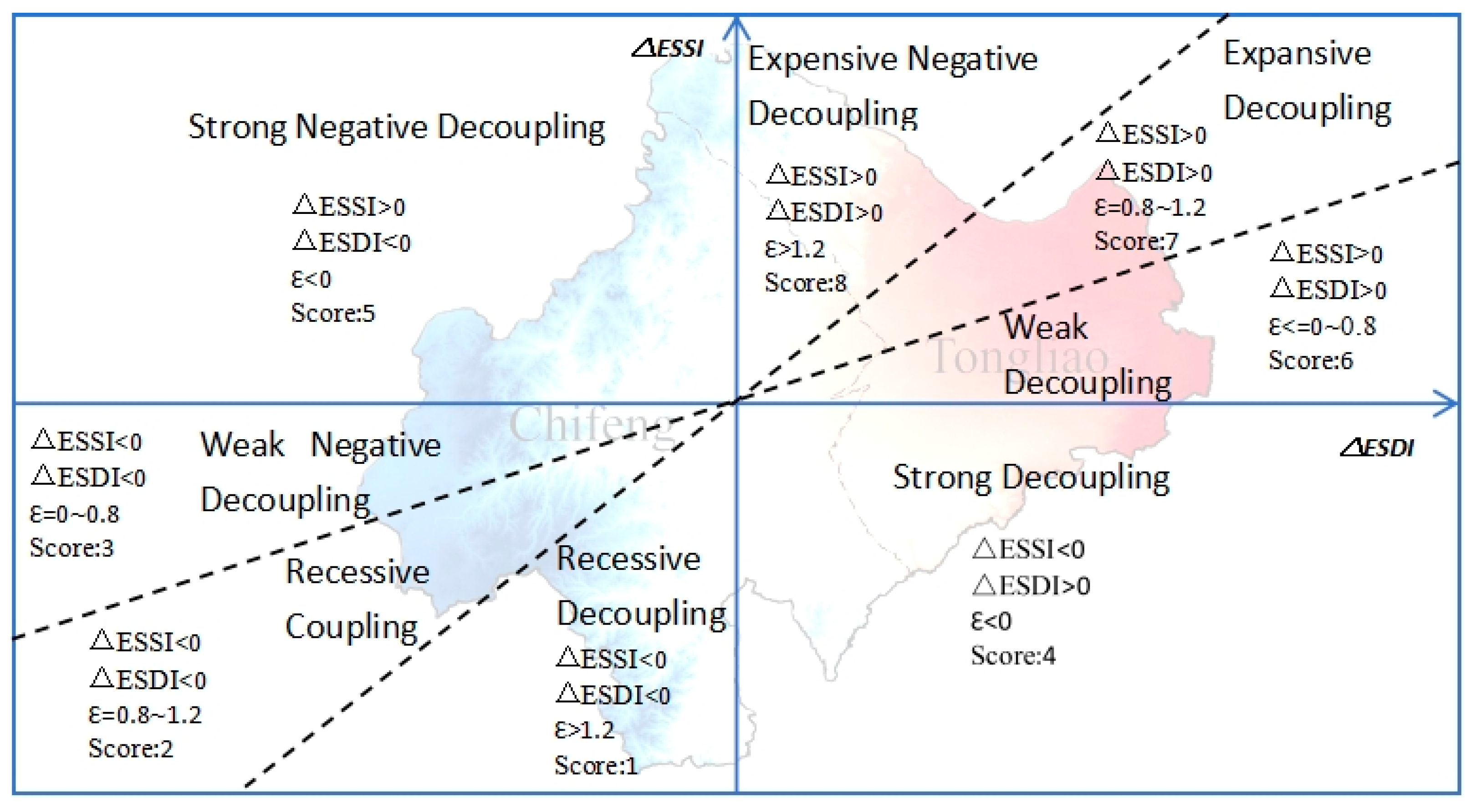

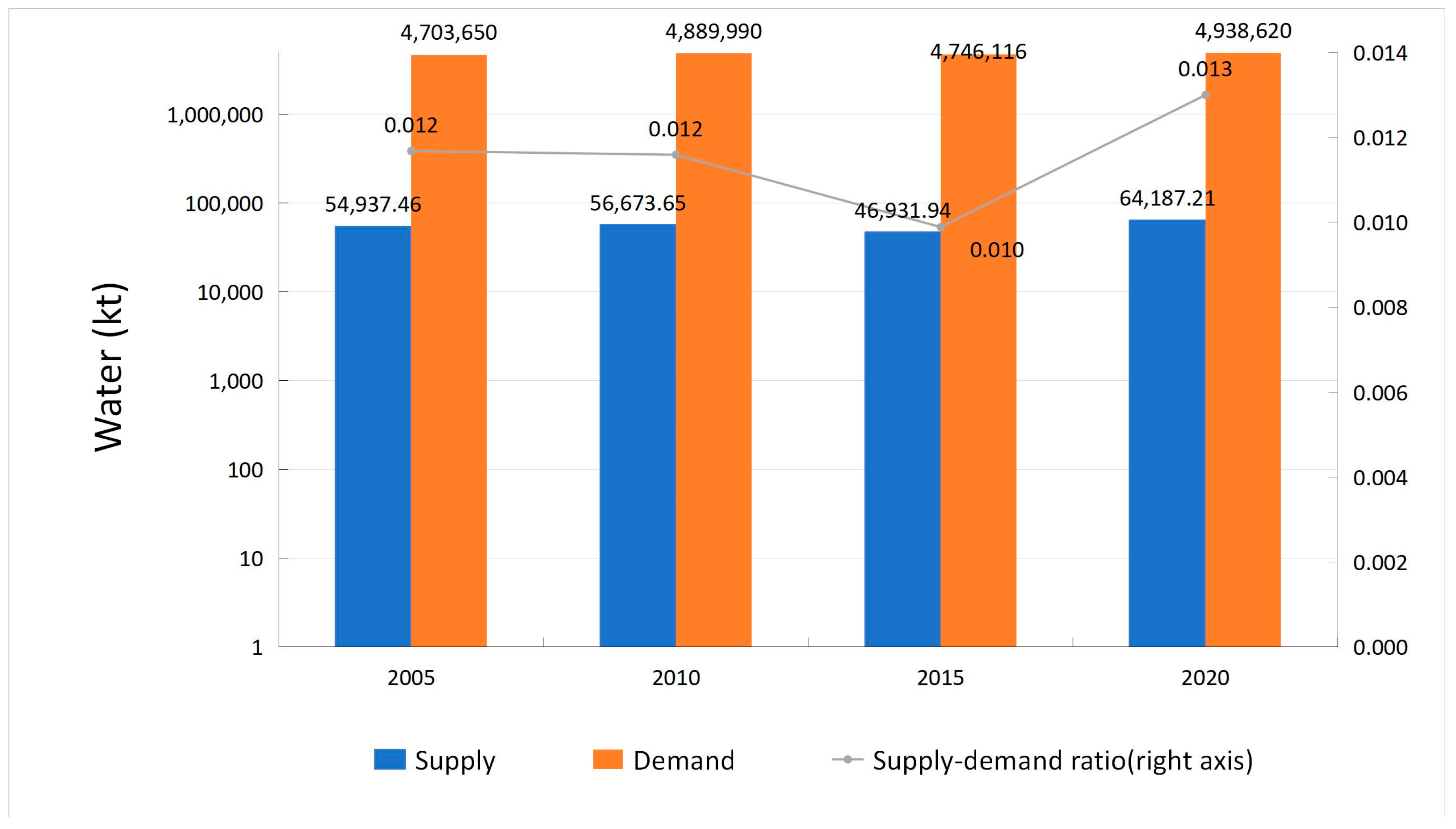
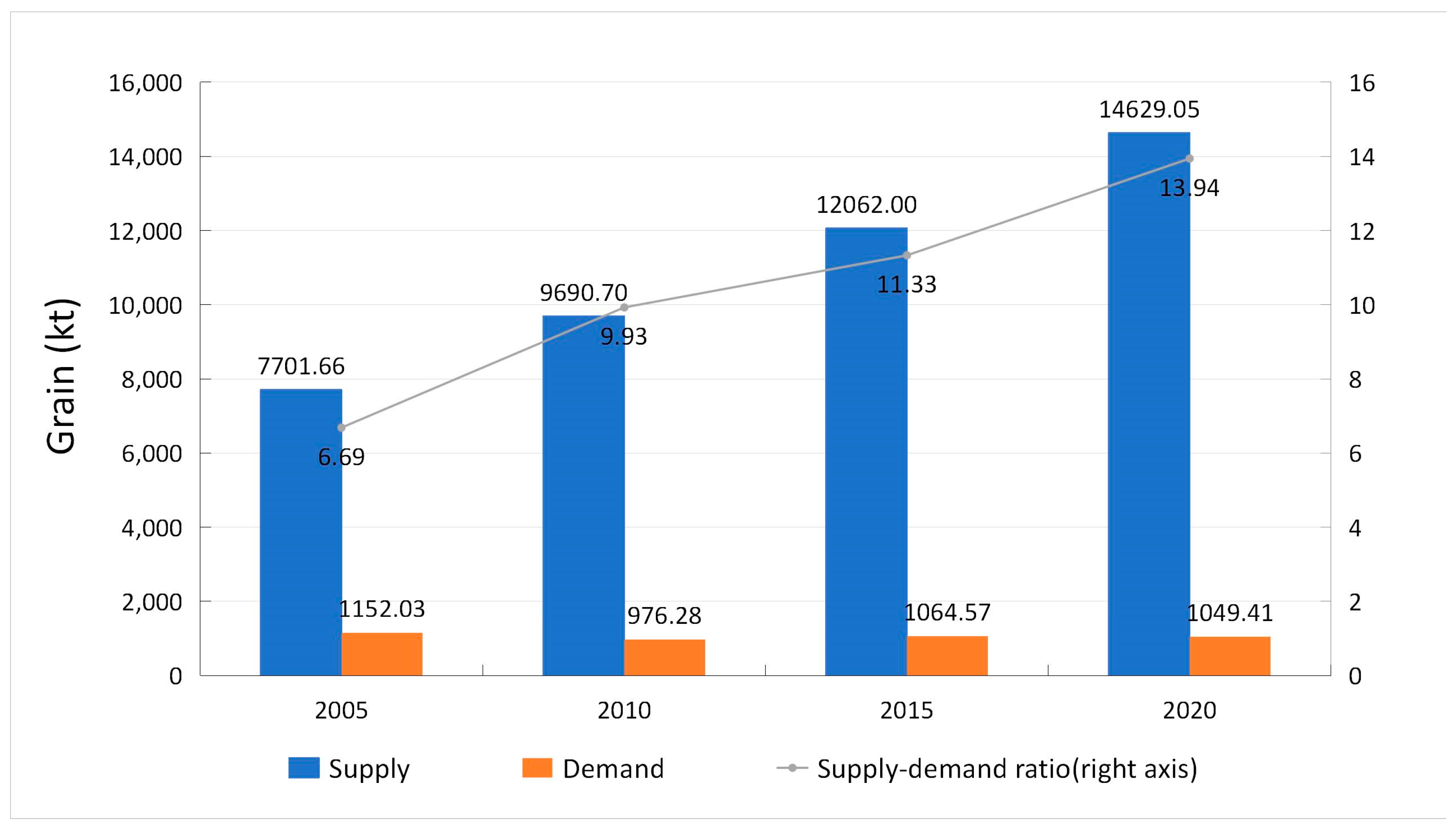
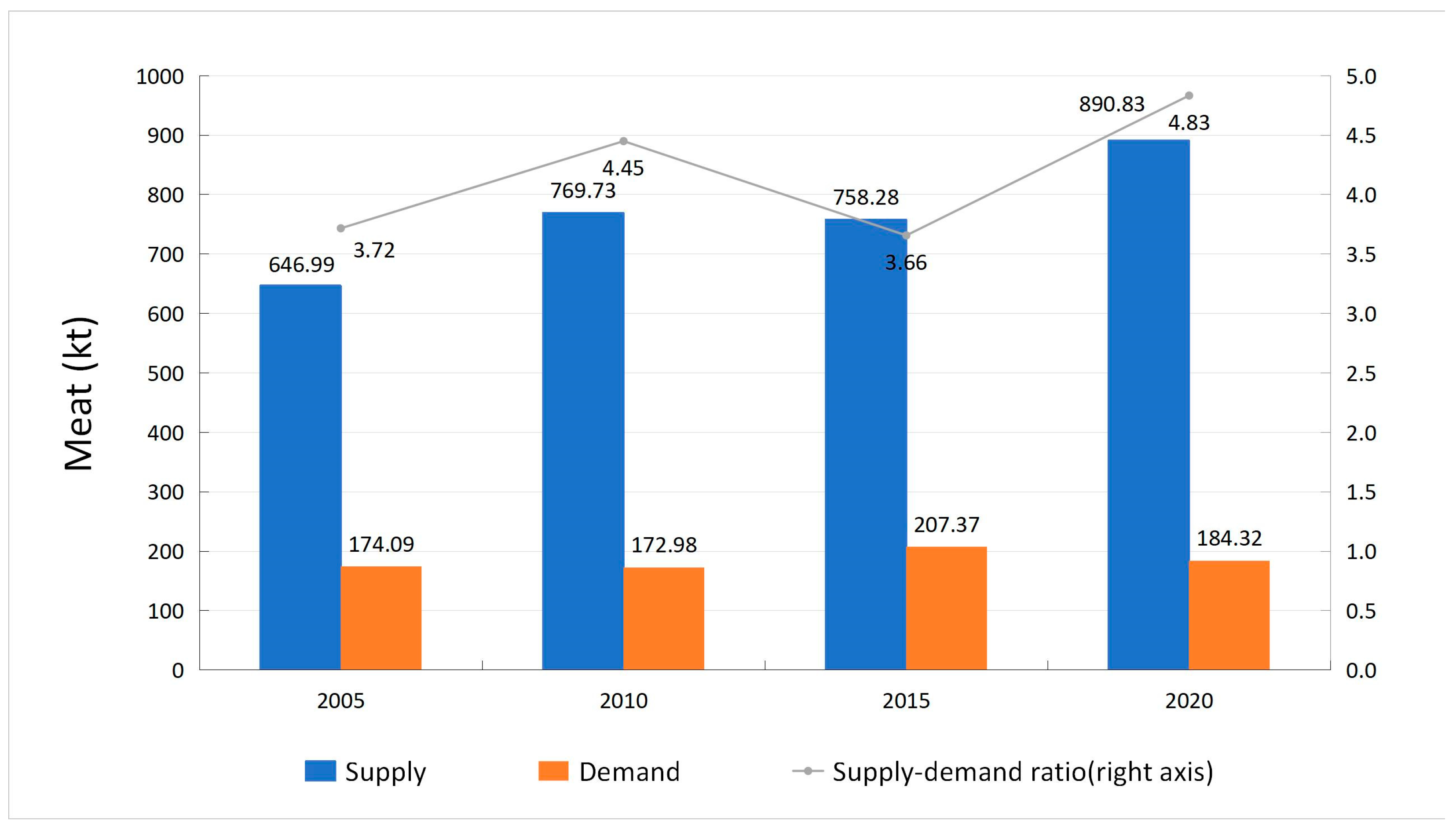
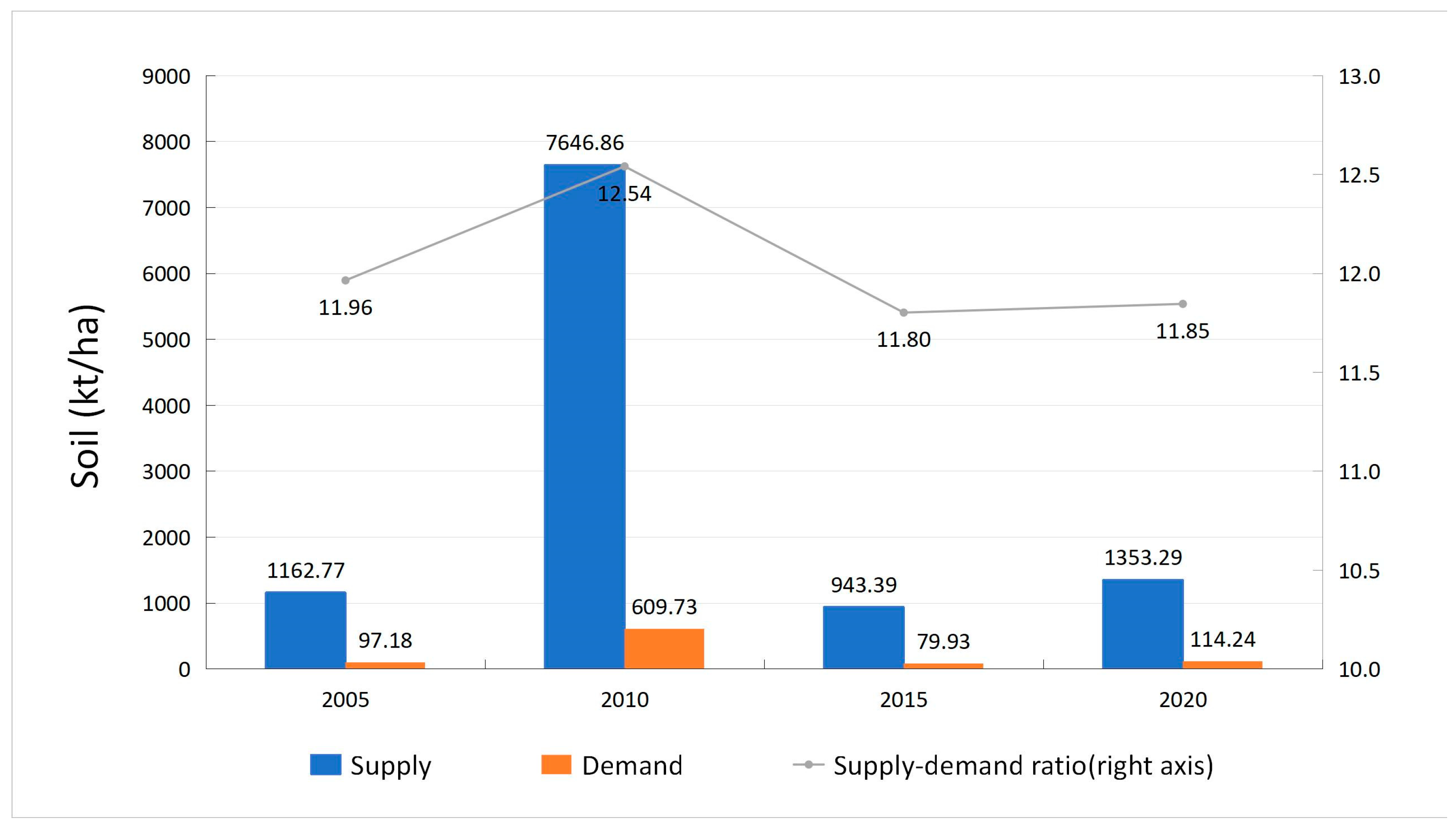
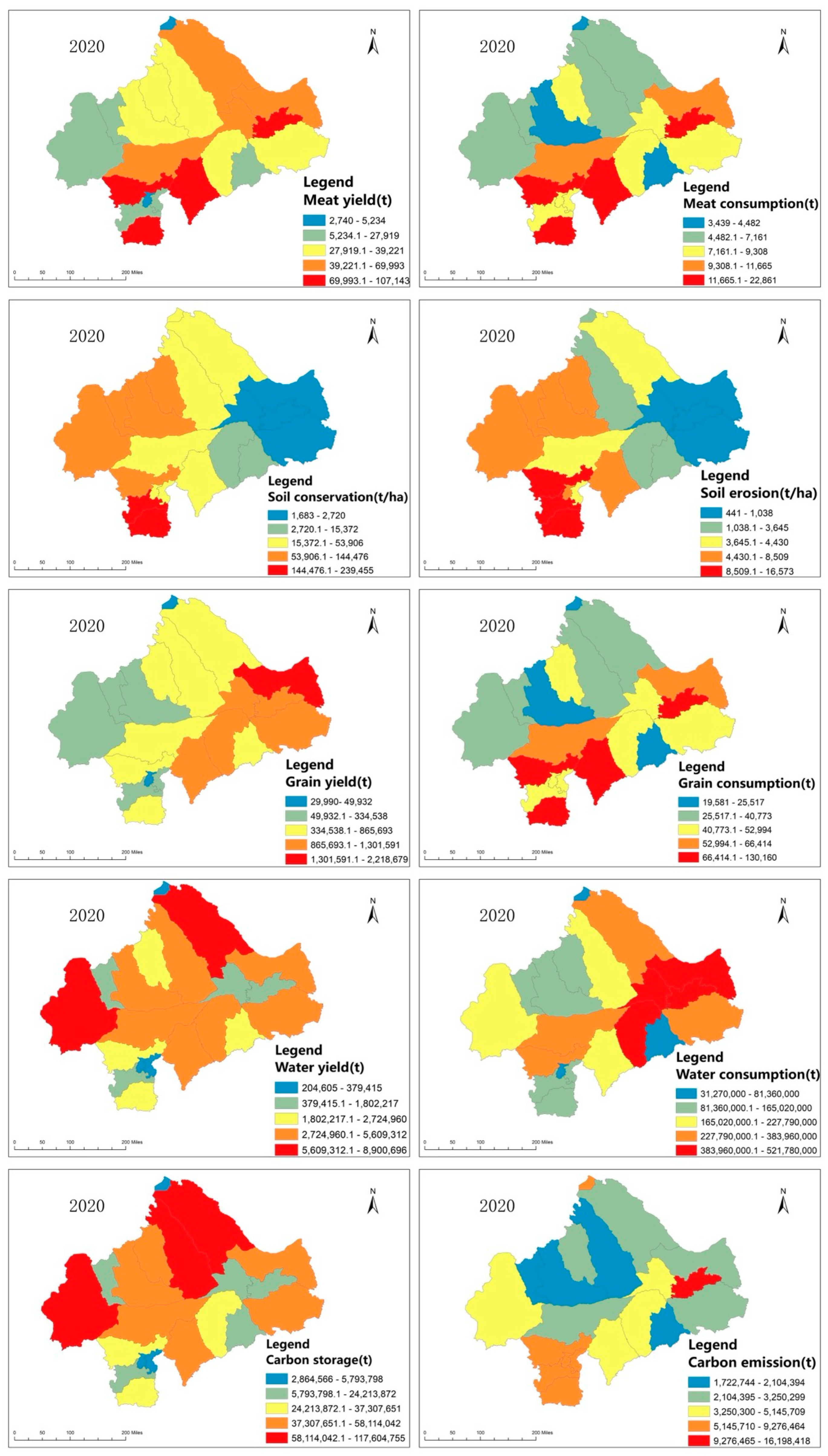
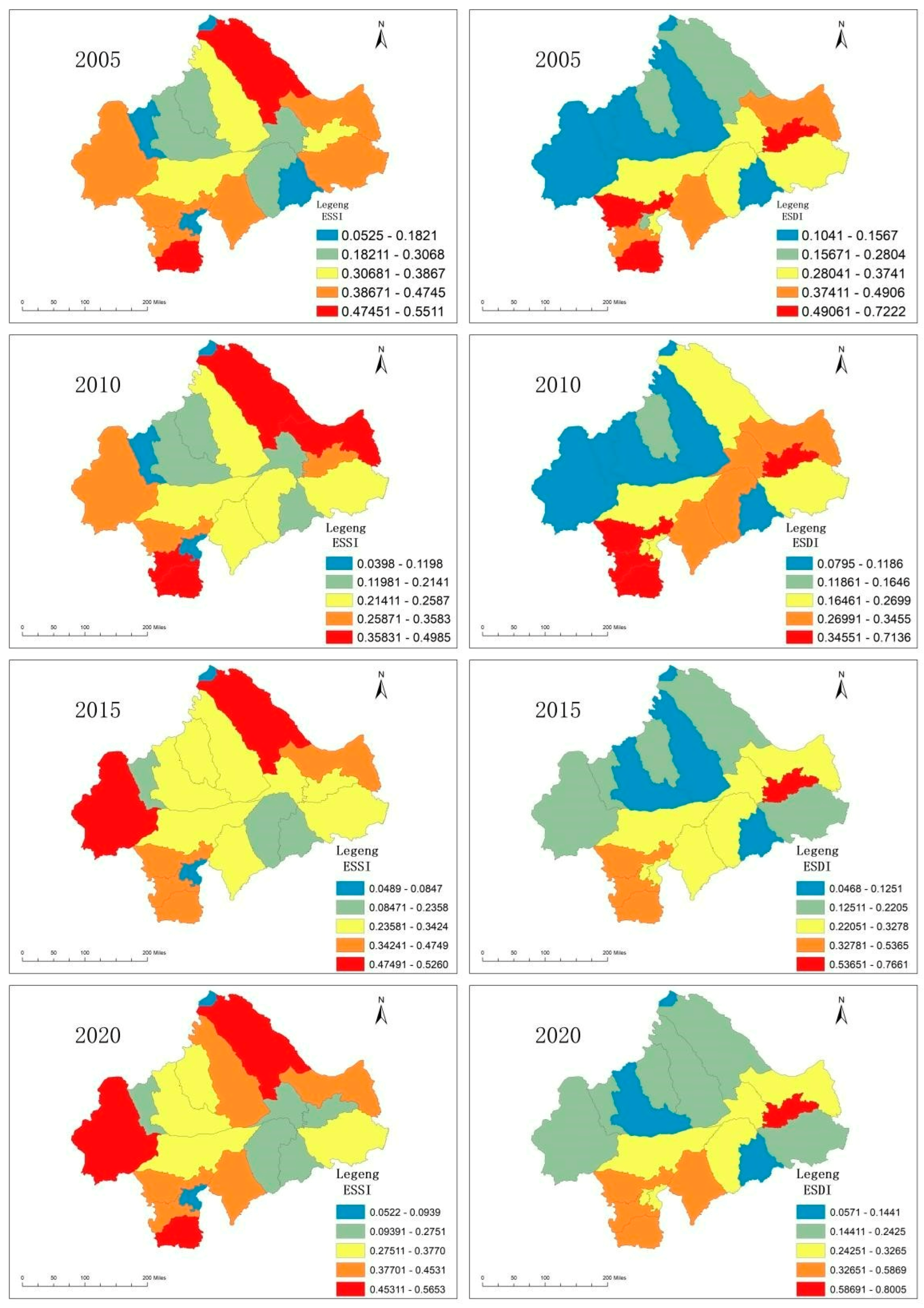
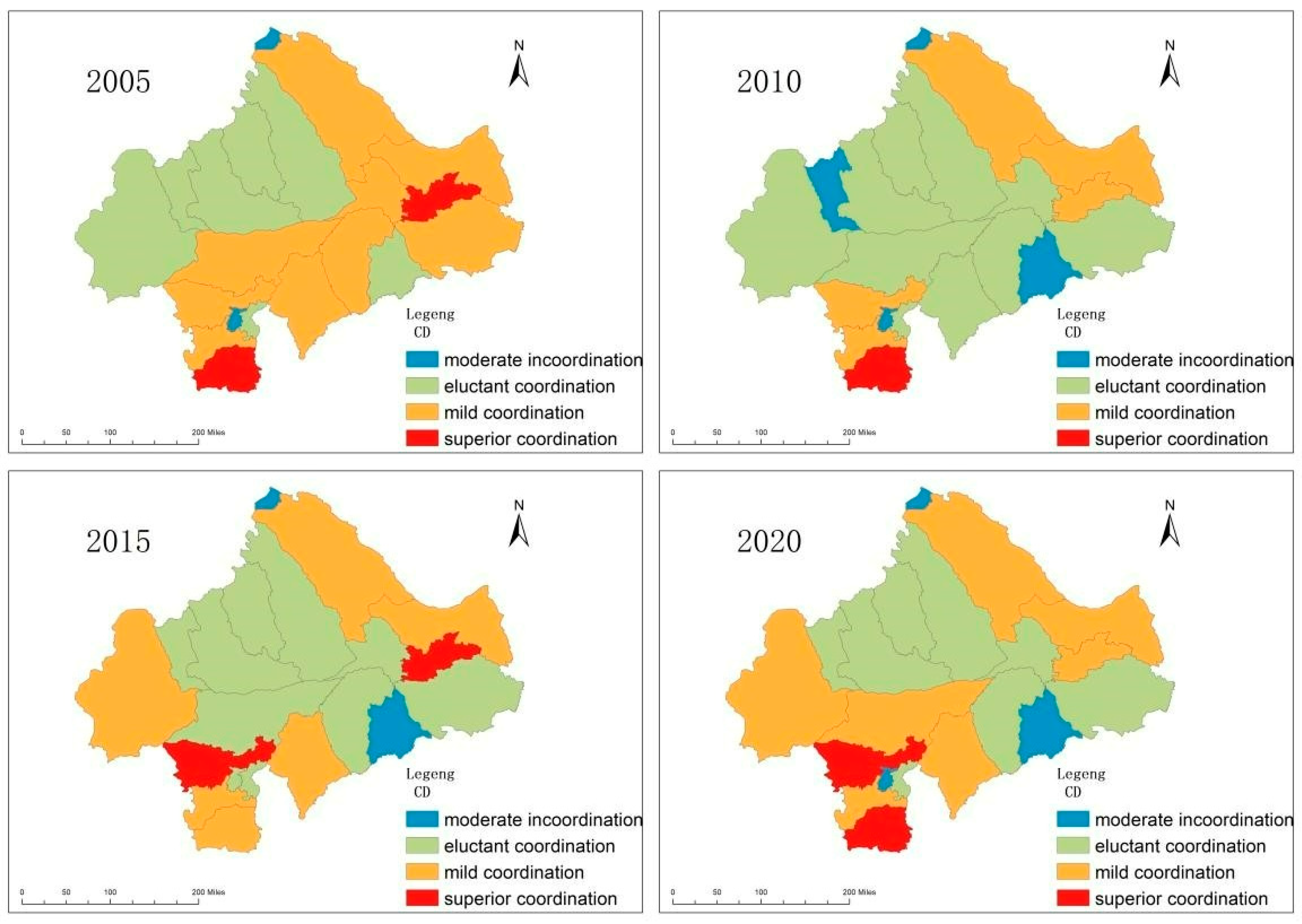



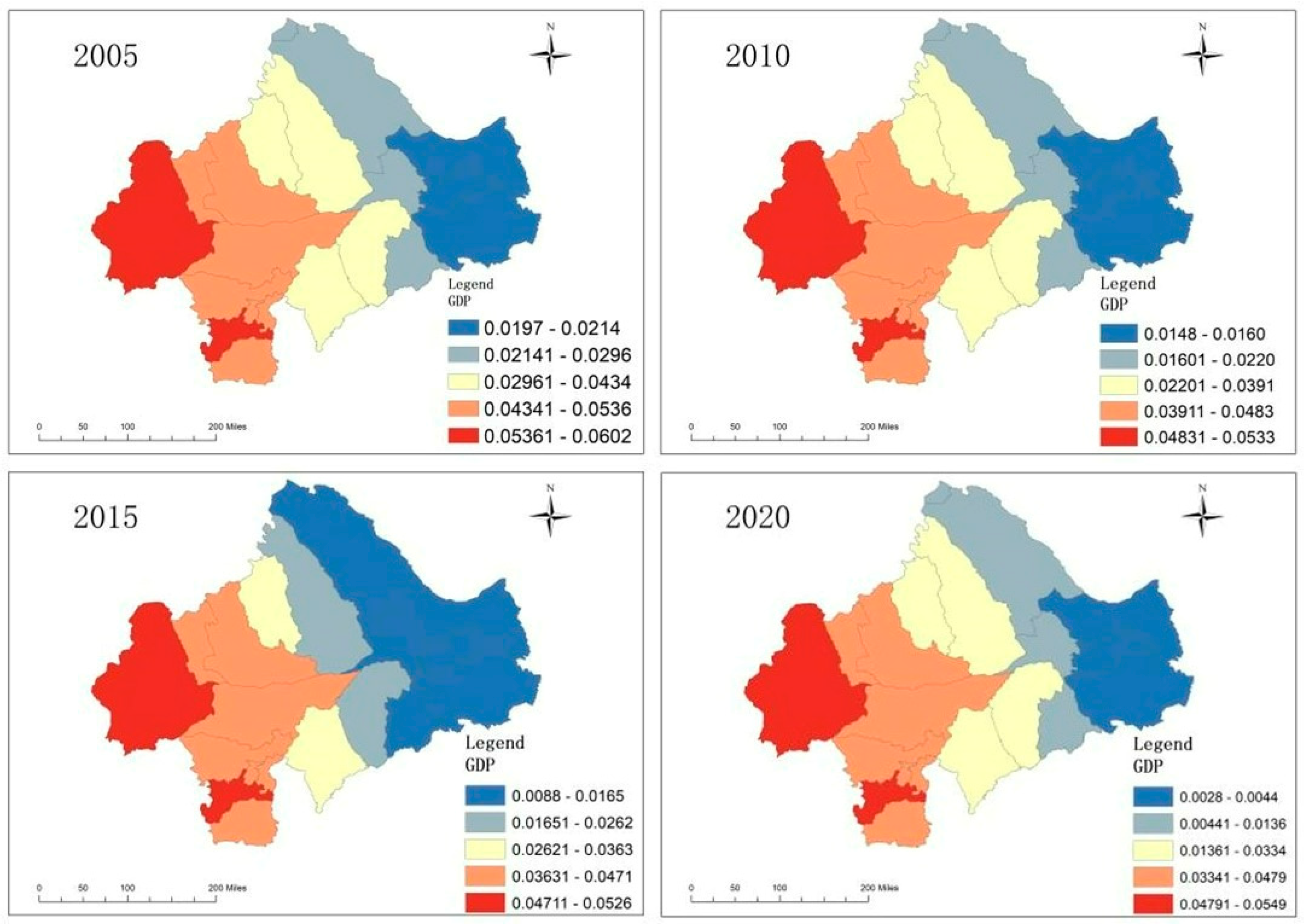






| Coupling Value | Coupling State |
|---|---|
| 0 ≤ CD ≤ 0.20 | extreme incoordination |
| 0.20 ≤ CD ≤ 0.35 | moderate incoordination |
| 0.35 ≤ CD ≤ 0.55 | basic coordination |
| 0.55 ≤ CD ≤ 0.70 | mild coordination |
| 0.70 ≤ CD ≤ 1 | superior coordination |
| Variables | p Value | Variance Inflation Factor |
|---|---|---|
| Population | <0.01 | 4.28 |
| GDP | 0.03 | 6.83 |
| NDVI | <0.01 | 5.78 |
| Precipitation | <0.0001 | 4.47 |
| Cropland | 0.02 | 6.42 |
| Forest land | <0.001 | 5.61 |
| Grasslands | 0.02 | 5.92 |
| Unused land | <0.0001 | 3.43 |
Disclaimer/Publisher’s Note: The statements, opinions and data contained in all publications are solely those of the individual author(s) and contributor(s) and not of MDPI and/or the editor(s). MDPI and/or the editor(s) disclaim responsibility for any injury to people or property resulting from any ideas, methods, instructions or products referred to in the content. |
© 2025 by the authors. Licensee MDPI, Basel, Switzerland. This article is an open access article distributed under the terms and conditions of the Creative Commons Attribution (CC BY) license (https://creativecommons.org/licenses/by/4.0/).
Share and Cite
Lyu, R.; Yuan, M.; Fu, X.; Tang, M.; Qu, L.; Yin, Z.; Wu, G. The Trade-Offs and Constraints of Watershed Ecosystem Services: A Case Study of the West Liao River Basin in China. Land 2025, 14, 119. https://doi.org/10.3390/land14010119
Lyu R, Yuan M, Fu X, Tang M, Qu L, Yin Z, Wu G. The Trade-Offs and Constraints of Watershed Ecosystem Services: A Case Study of the West Liao River Basin in China. Land. 2025; 14(1):119. https://doi.org/10.3390/land14010119
Chicago/Turabian StyleLyu, Ran, Meng Yuan, Xiao Fu, Mingfang Tang, Laiye Qu, Zheng Yin, and Gang Wu. 2025. "The Trade-Offs and Constraints of Watershed Ecosystem Services: A Case Study of the West Liao River Basin in China" Land 14, no. 1: 119. https://doi.org/10.3390/land14010119
APA StyleLyu, R., Yuan, M., Fu, X., Tang, M., Qu, L., Yin, Z., & Wu, G. (2025). The Trade-Offs and Constraints of Watershed Ecosystem Services: A Case Study of the West Liao River Basin in China. Land, 14(1), 119. https://doi.org/10.3390/land14010119






